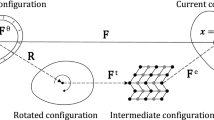Abstract
A mathematical theory is proposed rigorous construction and specialization of constitutive relations for simple (in the Noll’s sense) strain-hardening elastoplastic materials with an initial loading surface and a fading path shape memory at the active deformation segment. Strains and symmetry type of the material are taken to be arbitrary. Physical equations are derived for materials with no path shape memory, with a weak fading memory, and with a fading memory of the nth order. Based on the proposed constitutive relations, physical equations are constructed for isotropic materials. In the context of the fading path shape memory, a definition of an elastic-perfectly plastic material is given. Assuming the condition of smallness of measures of strains throughout the entire “past” history, a theory has been developed for rigorous construction and specialization of constitutive relations for materials with a first-order fading path shape memory for infinitesimal strains. Special emphasis is placed on isotropic materials.
Similar content being viewed by others
References
P. P. Lepikhin, “Simulation of the fading memory of form of the trajectory in the theory of simple materials with elastoplastic behavior. Part 1. Finite strains,” Strength Mater., 35, No. 5, 494–503 (2004).
P. P. Lepikhin, “Simulation of fading path shape memory in the theory of simple elastoplastically deforming materials,” in: Abstracts of Euromech (European Mechanics Society) Colloquium 458 “ Advanced Methods in Validation and Identification of Nonlinear Constitutive Equations in Solid Mechanics,” Moscow University Press, Moscow (2004).
P. P. Lepikhin, “Modeling for fading memory in the theory of Noll-simple materials with elastoplastic behavior,” in: Advanced Equipment and Processes in Mechanical Engineering, Instrument Engineering, and Welding Fabrication, Proc. Int. Conf. Dedicated to the 100th Anniversary of the Mechanical Engineering Department and 50th Anniversary of the Welding Engineering Department (25–28 May 1998) [in Russian], National Technical University of Ukraine “KPI,” Kiev (1998), Vol. 3, pp. 105–109.
P. P. Lepikhin, “Simulation of the fading memory of form of the trajectory in the theory of simple materials with elastoplastic behavior. Part 2. Infinitely small strains,” Strength Mater., 35, No. 6, 612–620 (2004).
V. T. Troshchenko, A. Ya. Krasovskii, V. V. Pokrovskii, et al., Resistance of Materials to Deformation and Fracture. Handbook [in Russian], Vol. 1, Naukova Dumka, Kiev (1993).
V. T. Troshchenko, A. Ya. Krasovskii, V. V. Pokrovskii, et al., Resistance of Materials to Deformation and Fracture. Handbook [in Russian], Vol. 2, Naukova Dumka, Kiev (1994).
C. Truesdell, A First Course in Rational Continuum Mechanics, The John Hopkins University, Baltimore (1972).
M. Lucchesi, D. R. Owen, and P. Podio-Guidugli, “Materials with elastic range: A theory with a view toward applications. Part 3: Approximate constitutive relations,” Arch. Rat. Mech. Analysis, 117, 53–96 (1992).
B. D. Coleman and W. Noll, “An approximation theorem for functionals, with applications in continuum mechanics,” Arch. Rat. Mech. Analysis, 6, 355–370 (1960).
B. D. Coleman and W. Noll, “Foundations of linear viscoelasticity,” Reviews Modern Phys., 33, 239–249 (1961).
C. Truesdell and W. Noll, The Non-Linear Field Theories of Mechanics, Springer, New York (1992).
R. M. Christensen, Theory of Viscoelasticity. An Introduction, Academic Press, New York, London (1971).
J. Casey, “Approximate kinematical relation in plasticity,” Int. J. Solids Struct., 21, No. 7, 671–682 (1985).
D. Komarov, A. Baltov, and N. Boncheva, Mechanics of Plastic Media [in Bulgarian], Izd. Blgarsk. Akad. Nauk, Sofia (1975).
A. M. Zhukov, “Some peculiarities of behavior of metals under elastoplastic deformation,” in: Issues of the Plasticity Theory, Izd. AN SSSR, Moscow (1961), pp. 30–57.
V. S. Lenskii, “Experimental validation of main postulates of the general theory of elastoplastic strains,” in: Issues of the Plasticity Theory, Izd. AN SSSR, Moscow (1961), pp. 58–82.
O. A. Shishmarev and E.Ya. Kuz’min, “On the dependence of metal elastic constants on plastic strains,” Izv. AN SSSR. Mekh. Mashinostr., No. 3, 167–169 (1961).
K. C. Valanis, “A theory of viscoplasticity without a yield surface. Part 1. General theory,” Arch. Mech., 23, No. 4, 517–533 (1971).
Author information
Authors and Affiliations
Additional information
__________
Translated from Problemy Prochnosti, No. 4, pp. 5–18, July–August, 2007.
Rights and permissions
About this article
Cite this article
Lepikhin, P.P. Simulation of fading path shape memory in the theory of simple materials with elastoplastic behavior and initial loading surface. Strength Mater 39, 339–348 (2007). https://doi.org/10.1007/s11223-007-0038-9
Received:
Issue Date:
DOI: https://doi.org/10.1007/s11223-007-0038-9




